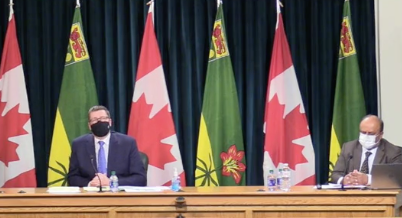
Saskatchewan’s COVID-19 situation is improving, the province said Thursday, even as key metrics lag behind the rest of Canada.
Chief Medical Health Officer Dr. Saqib Shahab pointed to a downward trend in positive tests and case rates while speaking to reporters in Regina.
The latest COVID-19 modelling shows a gradual decline in confirmed cases, ICU cases and hospitalizations through the end of March, so long as no variants of concern pop up in the province.
A slide shown by Shahab at Thursday’s media conference states that “improved adherence to public health measures” are required to accelerate that decline.
Still, the province trails the nation in its COVID-19 rate per 100,000, which sits at 120, and its active cases per 100,000, which sits at 172.
The seven-day average of new cases has fallen to 182, the lowest since Jan. 3 and a 43 per cent decline from its January peak.
Some key indicators, such as the daily test positivity rate and daily active cases are falling, though they’re still much too high in some regions, especially the north and far north.
“Things in Saskatchewan continue to trend in the right direction,” Premier Scott Moe said.
“Maybe a bit more gradual than we would like to see, but (case numbers and vaccines) are both trending in the right direction.”
Moe said residents have to keep adhering to current public health measures for the foreseeable future until a majority of residents can be vaccinated.
“What we have been doing … collectively is working. We need to keep doing it to protect ourselves and those around us.”
No new COVID-19 deaths were reported in Saskatchewan Thursday. It was the first time since mid-January that no new deaths were reported. Two Saskatoon residents diagnosed with COVID-19 had their deaths reported on Wednesday.
Saskatchewan reported 180 new cases and 245 recoveries Wednesday and 114 new cases and 147 recoveries Thursday. There have now been 23,674 recoveries since the pandemic began.
There are 187 people in the hospital province-wide. Of those, 19 are in the ICU.
The North Central Zone has 175 active cases, of which 71 are in Prince Albert. The zone also has 20 people in the hospital, including one in the ICU
Moe commits to faster rollout of rapid COVID-19 tests
Moe admitted Thursday that Saskatchewan should have dispersed rapid screening tests for COVID-19 “sooner.”
The province has over 400,000 of the tests. As of Thursday, only about 2.5 per cent had been used.
The tests are good for identifying negative cases and picking out possible positives for further testing.
“We need to do better,” Moe said Thursday.
He said tests would be sent to long-term care facilities, where they have already been in use, and to correctional facilities, schools and in Indigenous communities.
“We should have had those deployed sooner than today, but a number are being deployed and there are conversations about any remaining inventory,” he said.
Moe’s comments came the same day the NDP called on the province to introduce widespread rapid testing in schools, long-term care facilities, high-risk communities and workplaces.
Two methods are in use right now for rapid tests that can deliver results in about 22 minutes.
Abbott ID Now devices process a PCR test that detects the RNA of a virus. The SHA has deployed 74 Abbott ID Now machines to 47 acute care sites, 24 of which are conducting tests; staff are being trained at the other 23.
An antigen testing method, which detects the protein associated with a virus, is being used at 74 long-term care facilities. The Abbott Panbio tests use cartridges and do not rely on a device.
Staff at another 22 long-term care homes are being trained in Abbott Panbio testing. The aim of the antigen tests is to detect COVID-19 in staff and residents who are not experiencing symptoms.
The rapid tests are particularly useful for screening asymptomatic people. Positive results from rapid tests need to be confirmed by a lab, but the tests are useful for identifying people who test negative.
– With StarPhoenix files from Phil Tank.

